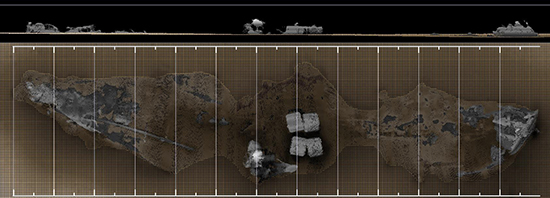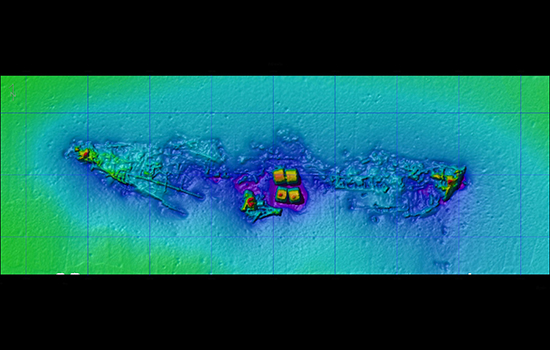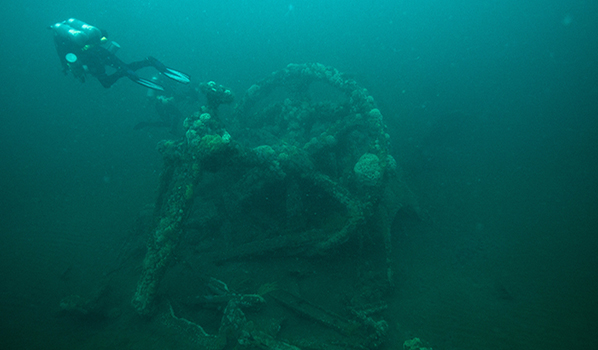City of Atlanta
Ship Stats
Location: 35°23'26.27"N, 75°20'10.43"W (35.39063, -75.33623)
Depth: 90 feet
Vessel Type: Freighter
Length: 377.5 feet Breadth: 49 feet
Gross Tonnage: 5,269 Cargo: Mostly food and a few passengers
Built: 1905, Delaware River I.S.B & Engineering Works, Chester, Pennsylvania, USA
Hull Number: 324 Port of Registry: Savannah, Georgia, USA
Owner: Ocean Steamship Company, Savannah, Georgia, USA
Lloyd's Register Details: Steel hull, Steam Screw, Single Screw, Solid Bronze Propeller (SBP), 3 decks, Machinery Amidships, Coal-fired Steam, Triple-expansion three-cylinder steam engine (T.3Cy), Engine 390 NHP, 2300 IHP, Four single ended Scotch Boilers
Former Names: N/A
Date Lost: January 19, 1942
Sunk By: U-123 Survivors: 3 of 46 (43 dead)
Data Collected on Site: Multibeam sonar survey; still and video photography
Significance: Casualty of World War II's Battle of the Atlantic
Wreck Site
The City of Atlanta rests in about 90 feet of water due east of Buxton, North Carolina. After the ship sank, it was considered a navigational hazard and wired dragged; therefore, today the site consists predominantly of a large debris field. However, the engine and boilers are prominent amidships with the prop shaft running aft to the propellers. A large circular structure, part of the ship's steering mechanism, is the most characteristic feature at the stern. While the site is generally flattened, there are three areas of high relief: the boilers, bow and stern sections.

The conditions on the site, being north of Cape Hatteras, are generally cooler and the visibility usually lower than sites in the Gulf Stream, thus making diving on the City of Atlanta, less frequent as other North Carolina wrecks.

Historical Background
From 1905 to its loss in 1942, City of Atlanta typically operated between Savannah and Philadelphia, New York and Boston to the north and Fernandina and Jacksonville to the south. Unfortunately, over the years there were three misfortunes for City of Atlanta resulting in collisions with three different vessels (1920, 1925, and 1930), with all three other vessels sinking.
In January 1942, City of Atlanta departed from New York heading to Savannah carrying almost 3,000 tons of cargo, mostly food, and a few passengers. It was early in the Battle of the Atlantic off the American coastline, so the ship's captain and crew were nervous. The captain had hoped to increase their chances of avoiding a U-boat attack by hugging the coastline and dimming navigational lights. However, unknown to City of Atlanta, one of the most successful U-boats of World War II, U-123, was patrolling the waters.
U-123 spotted the dim navigation lights of City of Atlanta as it was approaching about 8-10 miles off the North Carolina coast. The captain of U-123 began to easily track the cargo ship because he had found that merchant vessels followed a predictable route along the lighted buoys offshore. For almost three hours, U-123 tracked the ship before easing the U-boat to within 250 meters of City of Atlanta.

In the early hours of January 19, 1942, U-123 fired one torpedo striking City of Atlanta on the port side along the waterline. It struck with such force it set off a massive explosion, scattering debris for hundreds of meters. As U-123 took a "victory lap," City of Atlanta capsized to port and sank quickly. After spotting additional steamer lights, U-123 sped off to intercept while leaving City of Atlanta burning and three survivors clinging to the wreckage. After six hours, the survivors were finally rescued by Seatrain Texas. The sinking of City of Atlanta resulted in the largest loss of life among the ships torpedoed off North Carolina's coast.



